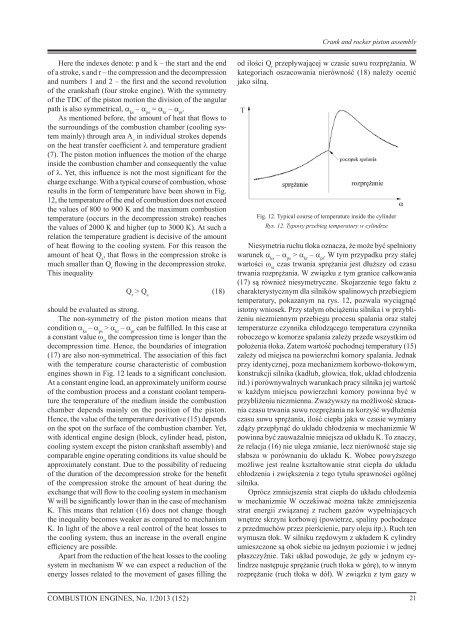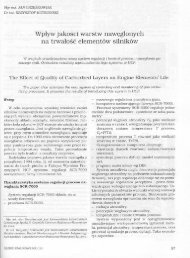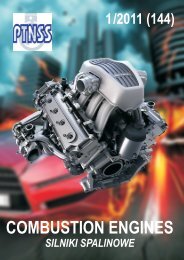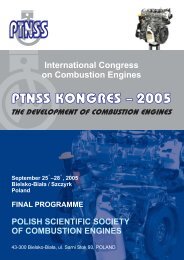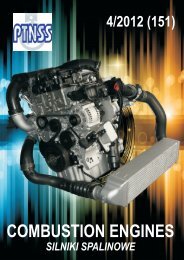You also want an ePaper? Increase the reach of your titles
YUMPU automatically turns print PDFs into web optimized ePapers that Google loves.
Crank and rocker piston assembly<br />
Here the indexes denote: p and k – the start and the end<br />
of a stroke, s and r – the compression and the decompression<br />
and numbers 1 and 2 – the first and the second revolution<br />
of the crankshaft (four stroke engine). With the symmetry<br />
of the TDC of the piston motion the division of the angular<br />
path is also symmetrical, a ks<br />
– a ps<br />
= a kr<br />
– a pr<br />
.<br />
As mentioned before, the amount of heat that flows to<br />
the surroundings of the combustion chamber (cooling system<br />
mainly) through area A z<br />
in individual strokes depends<br />
on the heat transfer coefficient l and temperature gradient<br />
(7). The piston motion influences the motion of the charge<br />
inside the combustion chamber and consequently the value<br />
of l. Yet, this influence is not the most significant for the<br />
charge exchange. With a typical course of combustion, whose<br />
results in the form of temperature have been shown in Fig.<br />
12, the temperature of the end of combustion does not exceed<br />
the values of 800 to 900 K and the maximum combustion<br />
temperature (occurs in the decompression stroke) reaches<br />
the values of 2000 K and higher (up to 3000 K). At such a<br />
relation the temperature gradient is decisive of the amount<br />
of heat flowing to the cooling system. For this reason the<br />
amount of heat Q s<br />
, that flows in the compression stroke is<br />
much smaller than Q r<br />
flowing in the decompression stroke.<br />
This inequality<br />
Q r<br />
> Q s<br />
(18)<br />
should be evaluated as strong.<br />
The non-symmetry of the piston motion means that<br />
condition a ks<br />
– a ps<br />
> a kr<br />
– a pr<br />
can be fulfilled. In this case at<br />
a constant value w śr<br />
the compression time is longer than the<br />
decompression time. Hence, the boundaries of integration<br />
(17) are also non-symmetrical. The association of this fact<br />
with the temperature course characteristic of combustion<br />
engines shown in Fig. 12 leads to a significant conclusion.<br />
At a constant engine load, an approximately uniform course<br />
of the combustion process and a constant coolant temperature<br />
the temperature of the medium inside the combustion<br />
chamber depends mainly on the position of the piston.<br />
Hence, the value of the temperature derivative (15) depends<br />
on the spot on the surface of the combustion chamber. Yet,<br />
with identical engine design (block, cylinder head, piston,<br />
cooling system except the piston crankshaft assembly) and<br />
comparable engine operating conditions its value should be<br />
approximately constant. Due to the possibility of reducing<br />
of the duration of the decompression stroke for the benefit<br />
of the compression stroke the amount of heat during the<br />
exchange that will flow to the cooling system in mechanism<br />
W will be significantly lower than in the case of mechanism<br />
K. This means that relation (16) does not change though<br />
the inequality becomes weaker as compared to mechanism<br />
K. In light of the above a real control of the heat losses to<br />
the cooling system, thus an increase in the overall engine<br />
efficiency are possible.<br />
Apart from the reduction of the heat losses to the cooling<br />
system in mechanism W we can expect a reduction of the<br />
energy losses related to the movement of gases filling the<br />
od ilości Q r<br />
przepływającej w czasie suwu rozprężania. W<br />
kategoriach oszacowania nierówność (18) należy ocenić<br />
jako silną.<br />
Fig. 12. Typical course of temperature inside the cylinder<br />
Rys. 12. Typowy przebieg temperatury w cylindrze<br />
Niesymetria ruchu tłoka oznacza, że może być spełniony<br />
warunek a ks<br />
– a ps<br />
> a kr<br />
– a pr<br />
. W tym przypadku przy stałej<br />
wartości w śr<br />
czas trwania sprężania jest dłuższy od czasu<br />
trwania rozprężania. W związku z tym granice całkowania<br />
(17) są również niesymetryczne. Skojarzenie tego faktu z<br />
charakterystycznym dla silników spalinowych przebiegiem<br />
temperatury, pokazanym na rys. 12, pozwala wyciągnąć<br />
istotny wniosek. Przy stałym obciążeniu silnika i w przybliżeniu<br />
niezmiennym przebiegu procesu spalania oraz stałej<br />
temperaturze czynnika chłodzącego temperatura czynnika<br />
roboczego w komorze spalania zależy przede wszystkim od<br />
położenia tłoka. Zatem wartość pochodnej temperatury (15)<br />
zależy od miejsca na powierzchni komory spalania. Jednak<br />
przy identycznej, poza mechanizmem korbowo-tłokowym,<br />
konstrukcji silnika (kadłub, głowica, tłok, układ chłodzenia<br />
itd.) i porównywalnych warunkach pracy silnika jej wartość<br />
w każdym miejscu powierzchni komory powinna być w<br />
przybliżeniu niezmienna. Zważywszy na możliwość skracania<br />
czasu trwania suwu rozprężania na korzyść wydłużenia<br />
czasu suwu sprężania, ilość ciepła jaka w czasie wymiany<br />
zdąży przepłynąć do układu chłodzenia w mechanizmie W<br />
powinna być zauważalnie mniejsza od układu K. To znaczy,<br />
że relacja (16) nie ulega zmianie, lecz nierówność staje się<br />
słabsza w porównaniu do układu K. Wobec powyższego<br />
możliwe jest realne kształtowanie strat ciepła do układu<br />
chłodzenia i zwiększenia z tego tytułu sprawności ogólnej<br />
silnika.<br />
Oprócz zmniejszenia strat ciepła do układu chłodzenia<br />
w mechanizmie W oczekiwać można także zmniejszenia<br />
strat energii związanej z ruchem gazów wypełniających<br />
wnętrze skrzyni korbowej (powietrze, spaliny pochodzące<br />
z przedmuchów przez pierścienie, pary oleju itp.). Ruch ten<br />
wymusza tłok. W silniku rzędowym z układem K cylindry<br />
umieszczone są obok siebie na jednym poziomie i w jednej<br />
płaszczyźnie. Taki układ powoduje, że gdy w jednym cylindrze<br />
następuje sprężanie (ruch tłoka w górę), to w innym<br />
rozprężanie (ruch tłoka w dół). W związku z tym gazy w<br />
<strong>COMBUSTION</strong> <strong>ENGINES</strong>, No. 1/2013 (152)<br />
21


